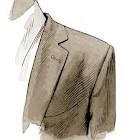The Shape of your jacket is important to making a good looking blazer. Like the collar, the shoulder structure of your jacket is an important component to make your jacket fit well and look sharp and professional. There are multiple components to add in your jacket shoulders to achieve the smooth structure.
1. Shoulder pads
a. Shoulder pads may be associated with the 80’s, but they are still well used and needed to shape your jacket shoulders. You may buy shoulder pads from the store, or you can make your own from pellon and fleece.
b. Shoulder pads should be large enough to cover your shoulder without intruding into the neckline.
c. Shoulder pads should be the correct thickness to fill in the hollow parts of a shoulder and for the style of jacket.
2. Sleeve heads
a. Sleeve heads aid shoulder pads in filling in the hollow parts that fall off the shoulder into the arm. They also prevent the seam allowance from showing through to the outside. Sleeve heads are easy to make but can be purchased as well.
b. Sleeve heads are sewn into the seam allowances so that the fold into the sleeve.
3. Further shaping
a. Depending on the weight of your fabric, stays on the front and/or back may also be needed to fill out the hollow spaces.
b. For front and back stays, use your pattern to cut a section that matches the shape of your shoulders from a light weight muslin, pin and stitch to shoulder seams.



























